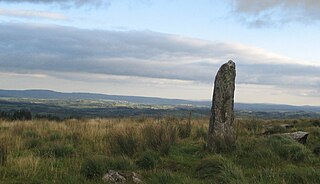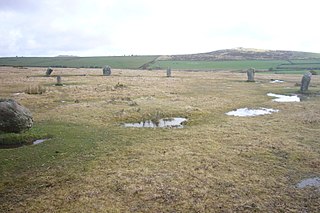
A menhir, standing stone, orthostat, or lith is a large man-made upright stone, typically dating from the European middle Bronze Age. They can be found individually as monoliths, or as part of a group of similar stones. Menhirs' size can vary considerably, but they often taper toward the top.

Alexander "Sandy" Thom was a Scottish engineer most famous for his theory of the Megalithic yard, categorisation of stone circles and his studies of Stonehenge and other archaeological sites.
The megalithic yard is a hypothetical ancient unit of length equal to about 2.72 feet (0.83 m). Some researchers believe it was used in the construction of megalithic structures. The proposal was made by Alexander Thom as a result of his surveys of 600 megalithic sites in England, Scotland, Wales and Brittany. Thom also proposed the megalithic rod of 2.5 megalithic yards, or on average across sites 6.77625 feet. As subunits of these, he further proposed the megalithic inch of 2.073 centimetres (0.816 in), one hundred of which are included in a megalithic rod, and forty of which composed a megalithic yard. Thom applied the statistical lumped variance test of J.R. Broadbent on this quantum and found the results significant, while others have challenged his statistical analysis and suggested that Thom's evidence can be explained in other ways, for instance that the supposed megalithic yard is in fact the average length of a pace.

Balquhain, also known as Balquhain Stone Circle, is a recumbent stone circle 3 miles (4.8 km) from Inverurie in Scotland. It is a scheduled ancient monument.
Goodaver, Goodaver stone circle or Goodaver circle is a stone circle located in the parish of Altarnun, near Bolventor on Bodmin Moor in Cornwall, UK.

The Trippet stones or Trippet stones circle is a stone circle located on Manor Common in Blisland, 9 kilometres (5.6 mi) north northeast of Bodmin on Bodmin Moor in Cornwall, UK. The Stripple stones are nearby.

The Nine Stones is a stone circle 3 kilometres (1.9 mi) south southeast of Altarnun, 11 kilometres (6.8 mi) west of Launceston on Bodmin Moor in Cornwall, UK.
Ardmulchan Passage Tomb is a passage grave and National Monument located in County Meath, Ireland.
Rockmarshall Court Tomb is a court cairn and National Monument located on the Cooley Peninsula, Ireland.
Cairnbaine, also called Tiredigan Court Tomb, is a court cairn and National Monument located in County Monaghan, Ireland.
Cummeen Court Cairn is a court cairn and National Monument located in County Sligo, Ireland.
The Seven Monuments is an embanked stone circle and National Monument located in County Galway, Ireland.

Ballynageeragh Portal Tomb is a dolmen and National Monument situated in County Waterford, Ireland.
The Coolcoulaghta Standing Stones are a pair of standing stones forming a stone row and National Monument located in County Cork, Ireland.
Farranahineeny Stone Row is a stone row and National Monument located in County Cork, Ireland.
Breeny More Stone Circle is an axial stone circle and National Monument located in County Cork, Ireland.
Carrigaphooca Stone Circle is a stone circle and National Monument located in County Cork, Ireland.
Cloghanecarhan is a ringfort and ogham stone forming a National Monument located in County Kerry, Ireland.
The Darrynane Beg Ogham Stone is an ogham stone and a National Monument located in County Kerry, Ireland.
Maughanasilly Stone Row is a stone row and National Monument located in County Cork, Ireland.






